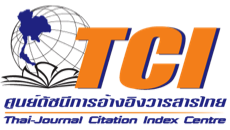กระบวนทัศน์ทางจิตตปัญญาศึกษาเพื่อเสริมสร้าง ความสามารถในการบริการด้วยหัวใจความเป็นมนุษย์สำหรับนักศึกษาพยาบาล (The Paradigm of Contemplative Education Enhance Humanized Care of Nursing Student)
คำสำคัญ:
กระบวนทัศน์ทางจิตตปัญญาศึกษา, การบริการด้วยหัวใจความเป็นมนุษย์, นักศึกษาพยาบาลบทคัดย่อ
การวิจัยครั้งนี้ มีวัตถุประสงค์เพื่อ 1) พัฒนาและหาคุณภาพของกระบวนทัศน์ทางจิตตปัญญาศึกษา เพื่อเสริมสร้างความสามารถในการบริการด้วยหัวใจความเป็นมนุษย์สำหรับนักศึกษาพยาบาล 2) เพื่อประเมินประสิทธิผลของกระบวนทัศน์ทางจิตตปัญญาศึกษา เพื่อเสริมสร้างความสามารถในการบริการด้วยหัวใจความเป็นมนุษย์สำหรับนักศึกษาพยาบาล และ 3) เพื่อขยายผลกระบวนทัศน์ทางจิตตปัญญาศึกษาเพื่อเสริมสร้างความสามารถในการบริการด้วยหัวใจความเป็นมนุษย์สำหรับนักศึกษาพยาบาล ดำเนินการวิจัยตามขั้นตอนของการวิจัยและพัฒนา กลุ่มตัวอย่างคือนักศึกษาพยาบาลศาสตร์ มหาวิทยาลัยสวนดุสิต ชั้นปีที่ 3 จำนวน 16 คน ได้มาโดยวิธีการสุ่มแบบแบ่งกลุ่ม เครื่องมือวิจัยที่ใช้ในการเก็บรวบรวมข้อมูล ประกอบด้วย แบบประเมินความสามารถในการบริการด้วยหัวใจความเป็นมนุษย์ แบบสัมภาษณ์ความสามารถในการบริการด้วยหัวใจ ความเป็นมนุษย์ และแบบบันทึกการเล่าเรื่องราว ซึ่งผ่านการตรวจสอบความตรงของเนื้อหา และมีค่าความเชื่อมั่นเท่ากับ 0.86 วิเคราะห์ข้อมูลเชิงปริมาณโดยใช้ค่าเฉลี่ย ส่วนเบี่ยงเบนมาตรฐาน และ Paired t-tests วิเคราะห์ข้อมูลเชิงคุณภาพโดยการวิเคราะห์เชิงเนื้อหา ผลการวิจัยพบว่า กระบวนทัศน์ทางจิตตปัญญาศึกษาเพื่อเสริมสร้างความสามารถในการบริการด้วยหัวใจความเป็นมนุษย์ประกอบด้วย หลักการ วัตถุประสงค์ กระบวนการเรียนรู้ การวัดและการประเมินผล และปัจจัยสนับสนุน ประสิทธิผลของกระบวนทัศน์ทางจิตตปัญญาศึกษาเพื่อเสริมสร้างความสามารถในการบริการด้วยหัวใจความเป็นมนุษย์ ผลการวิจัยพบว่า ความสามารถในการบริการ ด้วยหัวใจความเป็นมนุษย์หลังการใช้กระบวนทัศน์จิตตปัญญาศึกษาสูงกว่าก่อนใช้กระบวนทัศน์และพัฒนา การสูงขึ้น และนักศึกษากลุ่มขยายผลกระบวนทัศน์ทางจิตตปัญญาศึกษาหลังเรียนมีความสามารถในการบริการด้วยหัวใจความเป็นมนุษย์สูงกว่าก่อนเรียนและมีพัฒนาการสูงขึ้น
เอกสารอ้างอิง
Chiddee, K., Siriphan, S., Katenil, K., Tohpaeroh, M. and Kaleang, N. (2019). Learning Activities and Assessment Based on the Contemplative Education Philosophy. The Southern College NetworkJournal of Nursing and Public Health 6(3).145-157. (in Thai).
Chumpeeruang, S., Wattanator, A., Hingkanont, P.and Wareerat Keawurai, W. (2013). Development of Curriculum to Enhance Desirable Characteristics through Dialogue for Nursing Students, Journal of Education Naresuan University. 15(3), 9-15. (in Thai).
Hemingway et al. (2012). Humanising nursing care: a theoretical model. Nursing Times, 108 (40),26-27.
Heong, Y.M., & et al. (2012). The needs analysis of learning higher order thinking skills forhigher order thinking skills in undergraduate biology. Protoplasma, 249, 25-30.
James L. Levenson. (2005). Textbook of psychosomatic medicine. Viginia: American psychiatric publishing, Inc.
Joyce, B., Weil, M. and Calhoun, E. (2015). Model of Teaching. 9th ed. London: Allyn and Bacon.
Khemmone, T. Science of teaching: Knowledge for effective learning process. (2016). 12th ed. Bangkok: Chulalongkorn University Publishers; 2008. (in Thai).
Kolb, D. (1984). Experiential learning: Experience as the source of learning process. City: Prentice Hall.
Koolnaphadol, T., Laokosin,N., Pimmas, S and Prabhakar, K. (2019). Humanized care behaviors of Graduated Nurses in Bachelor of Nursing Science Program, Boromarajonani College of Nursing, Changwat Nonthaburi. Mahasarakham Hospital Journal 16(1): 90-97.
Nilchaikovit. T. (2008). Transformative learning and contemplative education. Contemplative Education: Education for Human Development. 2nded. Nakhon Pathom: Mahidol University. (in Thai).
Poorananon, P. and Panidchakul, K. (2018). Self-Development for Evidenced-Based Human caring in nursing students. Journal of Boromarajonani College of Nursing, Bangkok Journal of Boromarajonani College of Nursing, Bangkok,34(2) 125-137.
Prasrertsong, C., Benjamin, A and Pattana Wanfun, P. (2017). The Study to Confirm and Develop the Measure of Nursing Practice by Heart for Nursing Students. Journal of The Royal Thai Army Nurses 17(3)132-140. (in Thai).
Rose, G. (2012). Visual methodologies: An introduction to the interpretation of visual materials. 3rd ed. London: Sage.
Sessums, C.D. (2007). Contemplative practice: Transforming the meaning of education. Repeatdacamber24,2008.form http://eduspaces.net/csessums/ wabiog/ 145790.html.
Sirisoparuk, S and Oumtanee, A. (2014). Experience of Being a Professional Nurse Providing Humanized Care for Patients. Journal of The Royal Thai Army Nurses. 15(2): 189-297.
Soowit, B; Jeradechakul, P; Poolsuwan, S; & Thongprateap, T. (2013). Learning process for the holistic self-development of nursing students. Journal of The Royal Thai Army Nurses, 29(2), 25-34. (in Thai).
Sosome,B., Wiwekwan, Y and Suwannaka, Y. (2017). The Humanized Health Care Model for Nursing Care Pregnancy Women: Knowledge from Nursing Students’ Experiences. Journal of MCU Peace Studies, 5(2), 245-258.
Wasi P. (2011). Education system to solve the misery of people in the land. 2nd ed. Nakhon Pathom: Contemplative Education Center Mahidol University. (in Thai)
Watson, J. (2012) Human Caring Science: A Theory of Nursing. Massachusetts : Malloy.





